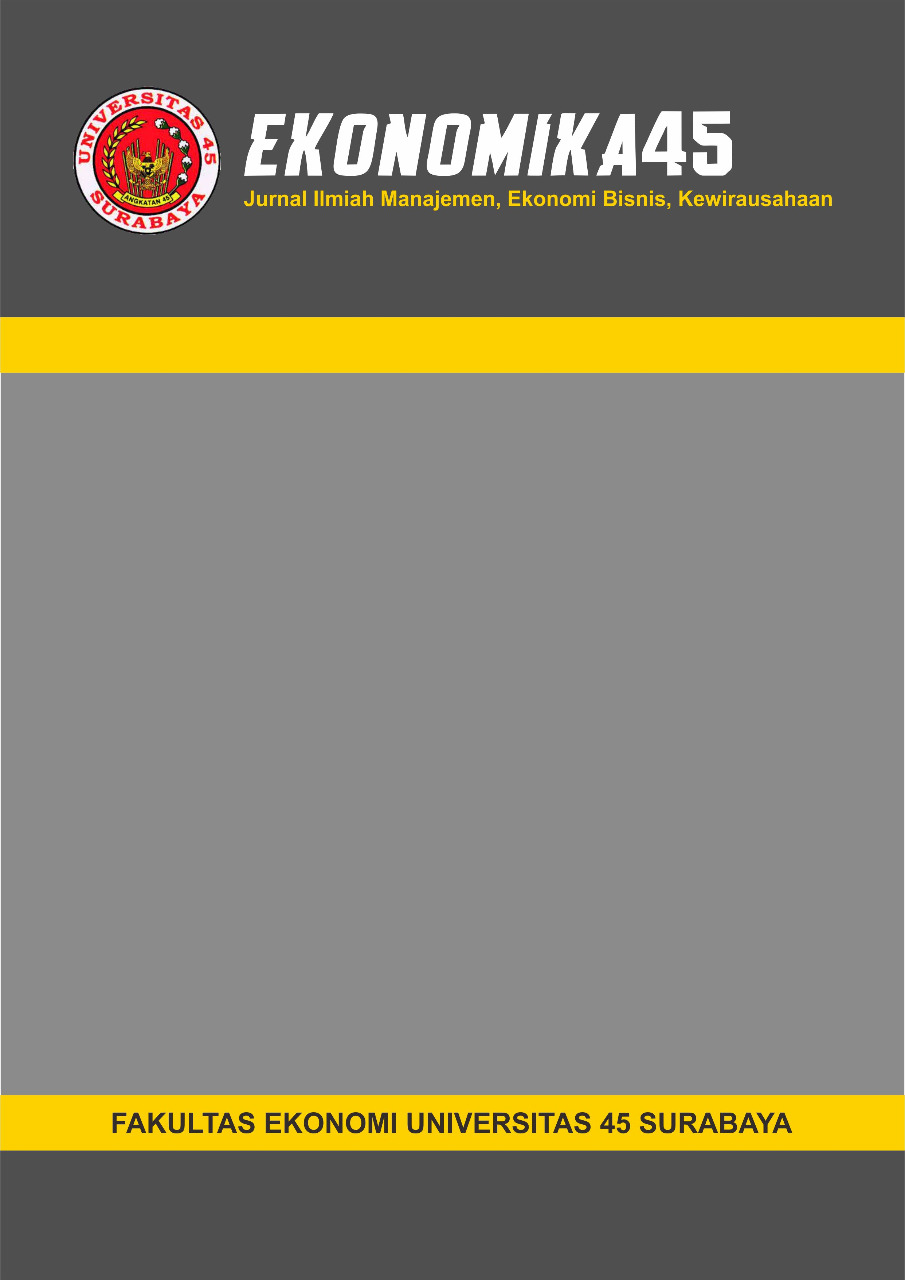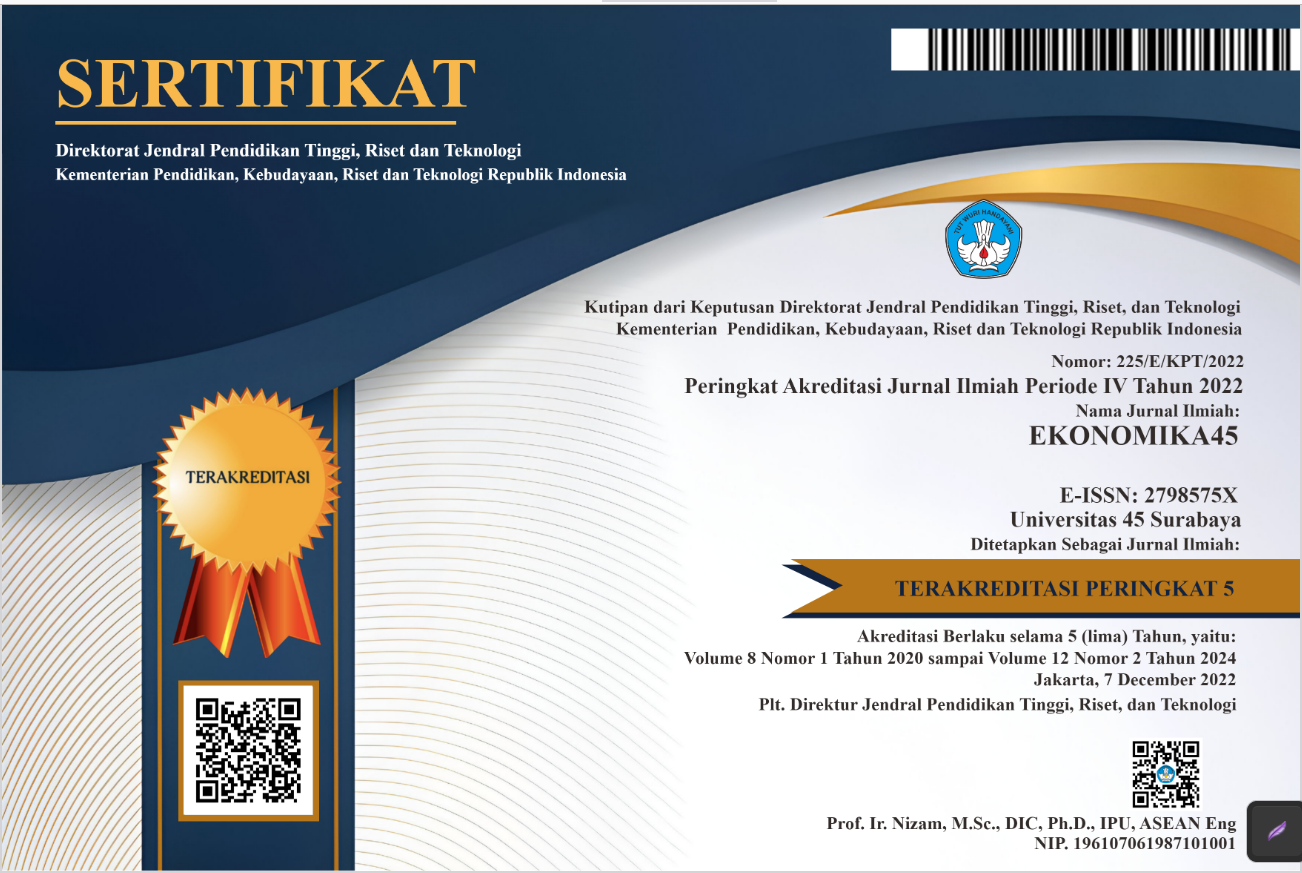Analisis Perencanaan Pembangunan Dan Pertumbuhan Ekonomi Hijau di Indonesia
DOI:
https://doi.org/10.30640/ekonomika45.v12i2.3006Keywords:
Environmental Quality, Green Economic Growth, Development PlanningAbstract
The purpose of this study is to analyze Development Planning and Green Economic Growth in Indonesia. Environmental damage and low public awareness of the environment encourage the need for sustainable development. Environmental damage occurs due to high exploitation of natural resources to meet economic interests without being followed by awareness to protect the environment. This research method uses a quantitative research design, considering that the variables studied are in the form of numbers that are processed using statistical methods. Testing of this variable uses the Panel Least Squares method data processing, the results of which will be interpreted to see the effect of the tested variables on the dependent variable. This test uses the variables of carbon emission growth, economic growth, population growth, and human development index on the Environmental Quality Index. The results of the study indicate that carbon emission growth and economic growth have a significant negative effect on the environmental quality index. Population does not affect the environmental quality index, while the Human Development Index has a significant positive effect on the environmental quality index. The implication of this study is that the government needs to maintain economic growth by paying attention to environmental conditions and minimizing carbon emissions so that environmental quality can be maintained. The quality of human capital also needs to be continuously improved so that public awareness of the importance of environmental quality.
References
Arifin, F. R., & Rahman, N. A. (2024). Anaisis Pengaruh Emisi Zat Karbon terhadap Kerusakan Kualitas Udara dan Pencemaran Lingkungan. INOVED, 2(1), 278–287.
Aulia, R. E., Budi, A. S., Pujiati, A., & Prajanti, S. D. W. (2024). Pengaruh Indeks Pembangunan Manusia dan Kepadatan Penduduk terhadap Indeks Kualitas Lingkungan Hidup di Pulau Jawa tahun 2012-2021. Jurnal Ganec Swara, 18(2), 724–729.
Byzzanthi, V., & Ermawati, W. (2021). Green Accounting, Financial Literacy, and Financial Performance: A Case Study on Sukaregang Tannery Industrial Center in Garut, West Java Indonesia. https://doi.org/10.4108/eai.14-9-2020.2304661
Cahyani, A., Ekayanti, D., Sa, D., Muzakky, A., Sugiarto, A., & Wahyu Eko Prasetyo, A. (2023). Green Energy, Globalization, FDI and Government Debt in Indonesia. Tamansiswa Accounting Journal International, 8(1). https://doi.org/10.54204/TAJI/Vol812023001
Chang, I., & Asari, A. (2023). Ekonomi Pembangunan (Solok). PT. Mafy Media Literasi Indonesia. www.penerbitmafy.com
Daryono, W. S., & Suharnomo, S. (2019). The development of green energy policy planning model to improve economic growth in Indonesia. International Journal of Energy Economics and Policy, 5(9), 216–223. https://doi.org/10.32479/ijeep.7779
Dimnwobi, S. K., Ekesiobi, C., Madichie, C. V, & Asongu, S. A. (2021). Population Dynamics and Environmental Quality in Africa. Science of the Total Environment, 797, 149–172.
Esther, A. M., & Suparyati, A. (2023). Pengaruh Kinerja Perekonomian terhadap Kualitas Lingkungan Hidup di Indonesia. Media Ekonomi, 31(1), 29–44.
Ginting, K. R., Pancawati, G., & Priyono, B. (2022). Empowering Women in Papua New Guinea as Part of the Green Economy. KnE Social Sciences. https://doi.org/https://doi.org/10.18502/kss.v7i9.11009
Gunawan, J., Permatasari, P., & Tilt, C. (2020). Sustainable development goal disclosures: Do they support responsible consumption and production? Journal of Cleaner Production, 246. https://doi.org/https://doi.org/10.1016/j.jclepro.2019.118989
Hartono, D., Hastuti, S. H., Halimatussadiah, A., Saraswati, A., Mita, A. F., & Indriani, V. (2022). Growing Light in the Lagging Region in Indonesia: The Impact of Village Fund on Rural Economic Growth. Heliyon, 6(6). https://doi.org/https://doi.org/10.1016/j.heliyon.2020.e04120
Kartika, N., & Purwiyanta. (2024). Determinasi Indeks Kualitas Lingkungan Hidup Provinsi di Pulau Jawa tahun2017-2022. Jurnal Ekonomi Regional, 16(2), 81–91.
Kurniawan, R., & Managi, S. (2018). Economic Growth and Sustainable Development in Indonesia: An Assessment. Bulletin of Indonesian Economic Studies, 54(3), 339–361. https://doi.org/https://doi.org/10.1080/00074918.2018.1450962
León-Gómez, A., Ruiz-Palomo, D., Fernández-Gámez, M. A., & García-Revilla, M. R. (2021). Sustainable tourism development and economic growth: Bibliometric review and analysis. Sustainability (Switzerland), 13(4), 1–20. https://doi.org/https://doi.org/10.3390/su13042270
Maneejuk, P., & Yamaka, W. (2021). The impact of higher education on economic growth in asean-5 countries. Sustainability (Switzerland), 13(2), 1–28. https://doi.org/https://doi.org/10.3390/su13020520
Musari, K. (2022). Integrating Green Sukuk and Cash Waqf Linked Sukuk, the Blended Islamic Finance of Fiscal Instrument in Indonesia: A Proposed Model for Fighting Climate Change. International Journal of Islamic Khazanah, 12(2), 133–144. https://doi.org/https://doi.org/10.15575/ijik.v12i2.17750
Nugraha, A. T., & Osman, N. H. (2019). CO2 emissions, economic growth, energy consumption, and household expenditure for Indonesia: Evidence from cointegration and vector error correction model. International Journal of Energy Economics and Policy, 9(1), 291–298. https://doi.org/https://doi.org/10.32479/ijeep.7295
Oktavia, P. A. D., Yunitasari, D., & Yuliati, L. (2021). Pengaruh Pertumbuhan Ekonomi dan Pertumbuhan Penduduk terhadap Kualitas Udara di Kawasan Gerbangkertosusila. Jurnal Ekonomi Pembangunan, 6(4), 1–9.
Purjayanto, Y. (2022). Analisis Pengaruh Pembangunan Ekonomi, Kualitas Sumber Daya Manusia, dan Kepadatan Penduduk terhadap Kerusakan Lingkungan di Pulau Jawa. Bestari, 3, 21–27.
Rahma, H., Fauzi, A., Juanda, B., & Widjojanto, B. (2019). Development of a composite measure of regional sustainable development in Indonesia. Sustainability (Switzerland), 11(20). https://doi.org/https://doi.org/10.3390/su11205861
Ramadhantie, S. S., Ramadhan, M. J., & Hasibuan, M. A. (2021). Pengaruh Indeks Pembangunan Manusia Terhadap Indeks Kualitas Lingkungan Hidup Di Indonesia Menggunakan Regresi Data Panel. Ekologia : Jurnal Ilmiah Ilmu Dasar Dan Lingkungan Hidup, 21(April), 35–43.
Sahab, A. (2019). Buku Ajar Analisis Kuantitatif Ilmu Politik dengan SPSS. Airlangga University Press.
Saleh, H., Surya, B., Ahmad, D. N. A., & Manda, D. (2020). The role of natural and human resources on economic growth and regional development: With discussion of open innovation dynamics. Journal of Open Innovation: Technology, Market, and Complexity, 6(4), 1–23. https://doi.org/https://doi.org/10.3390/joitmc6040103
Sasana, H., & Aminata, J. (2019). Energy subsidy, energy consumption, economic growth, and carbon dioxide emission: Indonesian case studies. International Journal of Energy Economics and Policy, 9(2), 117–122. https://doi.org/https://doi.org/10.32479/ijeep.7479
Saudi, M. H., Sinaga, O., Roespinoedji, D., & Razimi, M. S. A. (2019). The role of renewable, non-renewable electricity consumption and carbon emission in development in Indonesia: Evidence from distributed lag tests. International Journal of Energy Economics and Policy, 9(3), 46–52. https://doi.org/https://doi.org/10.32479/ijeep.7730
Spash, C. L. (2020). The economy’ as if people mattered: revisiting critiques of economic growth in a time of crisis. Globalizations, 1–18. https://doi.org/https://doi.org/10.1080/14747731.2020.1761612
Sulaiman, A. A., Sulaeman, Y., Mustikasari, N., Nursyamsi, D., & Syakir, A. M. (2019). Increasing sugar production in Indonesia through land suitability analysis and sugar mill restructuring. Land, 8(4). https://doi.org/https://doi.org/10.3390/land8040061
Sunday, A. T., Umarbeyli, S., Daniel, A. G., & Kirikkaleli, D. (2021). Environmental Science and Pollution. https://doi.org/https://doi.org/10.21203/rs.3.rs-285102/v1
Surya, B., Ahmad, D. N. A., Sakti, H. H., & Sahban, H. (2020). Land use change, spatial interaction, and sustainable development in the metropolitan urban areas, south Sulawesi province, Indonesia. Land, 9(3). https://doi.org/https://doi.org/10.3390/land9030095
Wayan Budiasa, I. (2020). Green financing for supporting sustainable agriculture in Indonesia. IOP Conference Series: Earth and Environmental Science. https://doi.org/https://doi.org/10.1088/1755-1315/518/1/012042
Wei, X., Ren, H., Ullah, S., & Bozkurt, C. (2023). Does environmental entrepreneurship play a role in sustainable green development? Evidence from emerging Asian economies. Economic Research-Ekonomska Istrazivanja, 36(1), 73–85. https://doi.org/https://doi.org/10.1080/1331677X.2022.2067887
Yuda, M. A. P., & Idris. (2022). Analisis Kepadatan Penduduk, Pertumbuhan Ekonomi dan Anggaran Lingkungan terhadap Kualitas Lingkungan Hidup di Indonesia. Jurnal Kajian Ekonomi Dan Pembangunan, 4(2), 53–62.
Zhang, J., Fan, Z., Chen, Y., Gao, J., & Liu, W. (2020). Decomposition and decoupling analysis of carbon dioxide emissions from economic growth in the context of China and the ASEAN countries. Science of the Total Environment, 714. https://doi.org/https://doi.org/10.1016/j.scitotenv.2020.136649
Downloads
Published
How to Cite
Issue
Section
License
Copyright (c) 2025 EKONOMIKA45 : Jurnal Ilmiah Manajemen, Ekonomi Bisnis, Kewirausahaan

This work is licensed under a Creative Commons Attribution-ShareAlike 4.0 International License.









